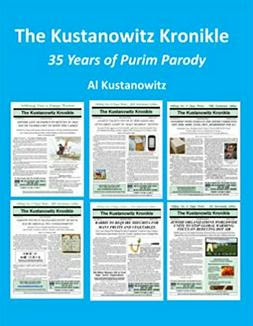Happy Purim to all of our Jewish Humor Central readers. We hope you enjoy this special Purim spoof from the Purim 2012 issue of The Kustanowitz Kronikle. You can download the PDF by clicking HERE. Print it and share it at your Purim Seudah. And coming tomorrow: THE KUSTANOWITZ KIDS' PICKS FOR THE 2011 SILVER GRAGGER MOVIE AWARDS
TALMUD FOUND IN JERUSALEM DIG;
GIVES GREEN LIGHT TO “HALF SHABBOS” TEXTING
TALMUD FOUND IN JERUSALEM DIG;
GIVES GREEN LIGHT TO “HALF SHABBOS” TEXTING
Tractate Textin Approves iPad, Kindle, and Nook (But Not Kindle Fire)
for Shabbat Reading; Kohen’s Ephod Was Prototype For Today’s iPad
for Shabbat Reading; Kohen’s Ephod Was Prototype For Today’s iPad
Special to The Kustanowitz Kronikle


FAIR LAWN, March 7 – The Orthodox Jewish world was shaken today by the announcement that a Talmud volume discovered last month in the City of David archaeological dig in Jerusalem seems to provide justification for the use of cell phones to send text messages on Shabbat.
The practice, used by Orthodox teens and popularly known as “keeping half-Shabbos” was widely reported in Jewish newspapers last summer.
The Talmud scrolls, titled Tractate Textin, describe in intricate detail the way that God communicated with the Kohen Gadol (High Priest) in the Temple.
When the people of Israel inquired of God concerning an important issue, the high priest asked God the question. God answered through the twelve stones. For example, when they wanted to know whether they should go out to war, the high priest asked God and God answered through the breastplate by making the stones glow in a sequence. This is the earliest known form of texting, and there are no specific prohibitions in the Torah nor halachic opinions in Talmud Textin that bar such communication on the Sabbath.
 A careful reading of Tractate Textin suggests that the Urim and Tumim were also used by the priests for activities that were not spelled out in the Torah. For example, there is a reference to Tziporim Koasot, or Angry Birds, presumably birds that were supposed to be sacrificed on the altar but were replaced by pigs when the Greek-Syrian army desecrated the Temple during the Hashmonean period.
A careful reading of Tractate Textin suggests that the Urim and Tumim were also used by the priests for activities that were not spelled out in the Torah. For example, there is a reference to Tziporim Koasot, or Angry Birds, presumably birds that were supposed to be sacrificed on the altar but were replaced by pigs when the Greek-Syrian army desecrated the Temple during the Hashmonean period. Other excerpts from Textin reveal that while the Kohen wasn’t looking, some Levites borrowed the Urim and Tumim to play ephod games and amuse themselves with other apps.
Permitted use of the Kindle and Nook was derived by scholars of Gematria, the study of numeric word equivalents. When spelled in Hebrew letters, Kindle has a numeric value of 194 and Nook has a value of 156, which are the same numeric values as the Hebrew words tzedek and Ohel Moed. If the Kindle represents tzedek, or righteousness, its use should be permitted at all times.
With the values of Nook and Ohel Moed (the tabernacle where the Ark of the Covenant rested and from where God spoke to Moses) being equivalent, the Nook gains a special holiness that merits its use on Shabbat.
Even though e-readers such as the Kindle, Nook, and iPad may be used on Shabbat, the latest model of the Kindle, the Kindle Fire, is specifically forbidden in the Torah (Exodus 35:3) which says "You shall not Kindle Fire throughout all your habitations upon the Sabbath day."















No comments:
Post a Comment